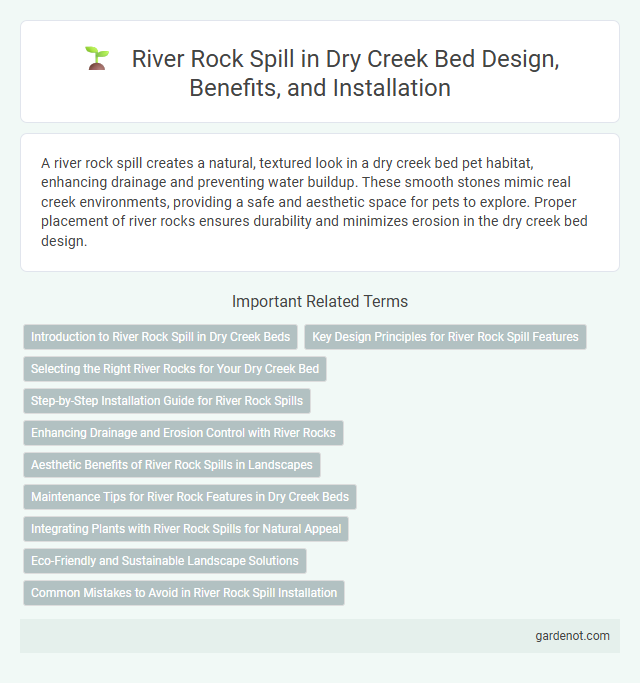A river rock spill creates a natural, textured look in a dry creek bed pet habitat, enhancing drainage and preventing water buildup. These smooth stones mimic real creek environments, providing a safe and aesthetic space for pets to explore. Proper placement of river rocks ensures durability and minimizes erosion in the dry creek bed design.
Introduction to River Rock Spill in Dry Creek Beds
River rock spill in dry creek beds refers to the strategic placement of smooth, rounded stones to control water flow and prevent soil erosion. These river rocks, typically ranging in size from 2 to 6 inches, create natural barriers that slow down water velocity during heavy rains. This method enhances groundwater recharge and stabilizes creek banks by dissipating energy from runoff, making it an effective erosion management technique.
Key Design Principles for River Rock Spill Features
River rock spill features require careful consideration of key design principles such as proper sizing and layering to ensure effective water flow and minimize erosion. Selecting appropriately graded river rocks enhances stability while allowing natural filtration and visual appeal. Incorporating a well-compacted base with adequate slope prevents stagnation and promotes seamless integration into the dry creek bed landscape.
Selecting the Right River Rocks for Your Dry Creek Bed
Selecting the right river rocks for your dry creek bed involves considering size, shape, and color to ensure both functionality and aesthetic appeal. Larger, smooth river rocks help with water flow management and erosion control, while smaller stones fill gaps and provide texture. Choosing natural, locally sourced stones can enhance the landscape's harmony and sustainability.
Step-by-Step Installation Guide for River Rock Spills
Begin the river rock spill installation by clearing the dry creek bed area, removing debris and leveling the ground for proper drainage. Lay a landscaping fabric to prevent weed growth and ensure structural stability before spreading a 2-3 inch layer of river rocks evenly across the bed. Finish by securing the edges with larger rocks or metal edging to maintain the spill's shape and enhance the natural look of the dry creek bed.
Enhancing Drainage and Erosion Control with River Rocks
River rock spills significantly improve drainage by allowing water to flow through gaps between the stones, preventing water accumulation in dry creek beds. These durable rocks reduce soil erosion by stabilizing the surface and dispersing water runoff evenly across the area. Strategically placed river rocks also enhance landscape aesthetics while supporting sustainable water management in dry creek environments.
Aesthetic Benefits of River Rock Spills in Landscapes
River rock spills enhance landscape aesthetics by creating natural visual appeal with their smooth textures and varied earth tones, which complement both modern and rustic garden designs. Their ability to reflect sunlight adds subtle brightness and depth, while the irregular shapes and sizes produce a dynamic yet harmonious ground cover that contrasts beautifully with plants and hardscapes. These rocks also help define pathways and garden beds, contributing to a polished and cohesive outdoor environment.
Maintenance Tips for River Rock Features in Dry Creek Beds
Regularly removing debris from river rock spills in dry creek beds prevents clogging and maintains proper water flow. Periodic washing and replenishing of river rocks preserve their appearance and function by preventing dirt buildup and erosion. Applying weed barriers beneath the rocks minimizes weed growth, reducing maintenance efforts and enhancing the overall durability of the dry creek bed feature.
Integrating Plants with River Rock Spills for Natural Appeal
River rock spills create a dynamic foundation for integrating drought-tolerant plants, enhancing both drainage and visual interest in a dry creek bed. Selecting native grasses, succulents, and ground covers that thrive around river rocks promotes a natural, low-maintenance landscape that mimics natural riparian environments. Combining textured river rock with resilient plants supports soil stability, prevents erosion, and attracts local wildlife, fostering a sustainable and aesthetically pleasing outdoor space.
Eco-Friendly and Sustainable Landscape Solutions
River rock spills create natural drainage areas that minimize soil erosion and promote water retention, offering an eco-friendly alternative to synthetic materials. Utilizing locally sourced, durable river rocks reduces the carbon footprint associated with transportation and manufacturing processes, emphasizing sustainable landscaping. This approach supports biodiversity by providing habitats for small wildlife and helps maintain natural water cycles in dry creek bed designs.
Common Mistakes to Avoid in River Rock Spill Installation
Incorrect placement of river rocks can cause uneven surfaces and drainage issues in a dry creek bed, resulting in water pooling or erosion. Using rocks that are too small or lightweight often leads to displacement during heavy rain or water flow. Neglecting proper layering with landscape fabric beneath the river rocks allows weeds to grow and reduces long-term stability of the river rock spill installation.
River rock spill Infographic

 gardenot.com
gardenot.com